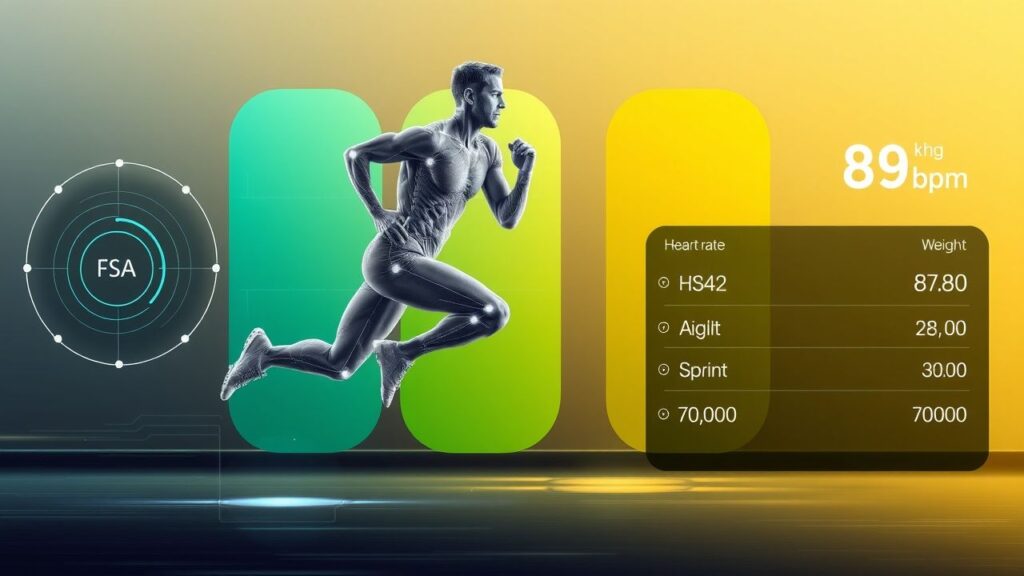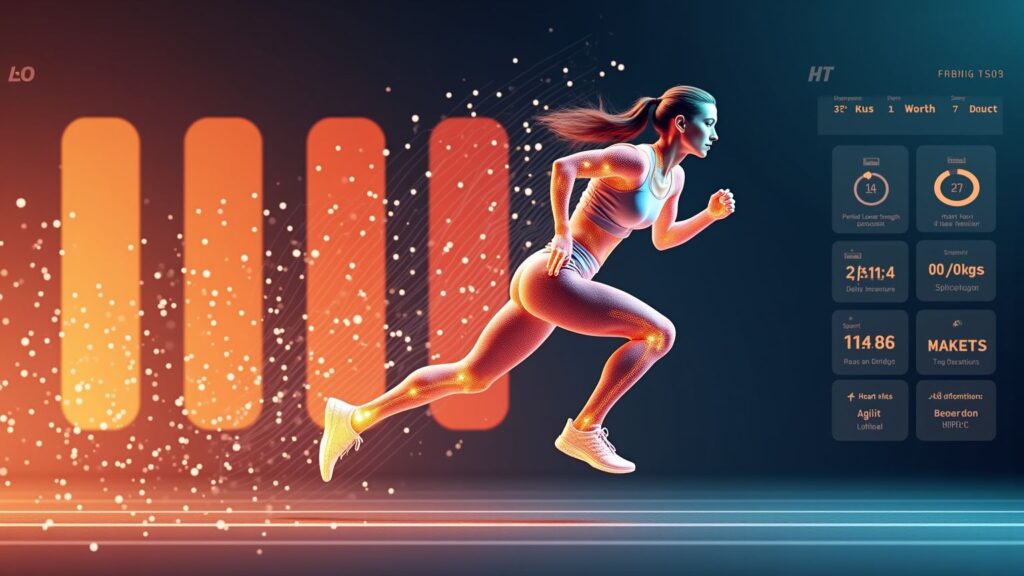Revolutionizing Performance: The Future of AI Sports Tracking Technology in 2025
Sports aren’t just about the athletes on the field; they’re about the fans cheering in the stands or from their…

Sports aren’t just about the athletes on the field; they’re about the fans cheering in the stands or from their living rooms. AI sports tracking is transforming the fan experience, making it more immersive and interactive than ever before. With AI, you’re no longer just a spectator—you become part of the action.
Imagine watching a game where you can instantly view real-time stats, player performance updates, and predictive analytics all on your screen.
AI-powered tools can deliver this, turning a traditional game broadcast into a dynamic, data-rich experience. Platforms like Amazon Web Services (AWS) and IBM Watson are already leveraging AI to enhance fan engagement through instant replays, player movement analysis (see Yogger), and even forecasting game outcomes based on historical data.
But it doesn’t stop there.
Augmented reality (AR) applications, powered by AI, enable fans at live events to overlay stats and visuals on their smartphone screens as they watch the game. AI chatbots and voice assistants are also redefining customer service for sports fans, offering instant responses to everything from ticket inquiries to game schedules.
The result?
A deeply personalized and engaging experience that makes you feel like you’re more than just a passive observer. With AI, the bond between fans and sports is closer, smarter, and undeniably electrifying.
Understanding AI Sports Tracking

The Evolution of Sports Tracking Technology
Sports tracking (or sports vision) technology has come a long way from simple stopwatches and clipboards. Decades ago, assessing athletic performance relied heavily on a coach’s eye and manual note-taking. While this approach had its merits, it left much to subjective opinion, with no way to capture the granular data needed to truly transform an athlete’s game.
Enter digital tracking, which emerged in the late 20th century. Heart rate monitors, GPS devices, and motion sensors were game-changers, providing athletes with quantifiable metrics such as speed, distance, and endurance.
But even these tools had limitations, often requiring manual operation and lacking deeper insights about strategy or real-time decision-making. The evolution truly gained momentum when video analysis software became popular. Coaches could now review games frame by frame, dissecting plays and identifying patterns that were hard to spot in real time.
Today, artificial intelligence (AI) is the new frontier in sports tracking technology. By leveraging machine learning algorithms, AI systems can analyze enormous datasets in seconds, providing insights that were once unimaginable.
These systems integrate video analysis, biometric data, and even predictive modeling, enabling athletes and teams to achieve a level of optimization that was unthinkable even a decade ago. Sports tracking has never been more precise—or more exciting.
How AI Enhances Sports Analytics
When it comes to sports analytics, AI has become a game-changer, opening up possibilities that were once unimaginable. Imagine having the ability to analyze every second of play, track a player’s every move, and predict future performance—all in real time. That’s the power AI brings to the table.
AI enhances sports analytics through unparalleled data processing and precision. Traditional methods of tracking stats like points scored or passes completed are no longer enough. AI goes deeper. It can process massive amounts of data from wearable sensors, video footage, and even social media interactions, uncovering patterns that would take humans hours—or days—to decipher.
For instance, machine learning algorithms can forecast how a particular lineup will perform against a specific opponent or identify subtle signs of fatigue in a player.
One of the most fascinating advancements is how AI translates raw data into actionable insights. Through predictive modeling, AI can pinpoint a team’s weak spots, recommend lineup optimizations, and even anticipate in-game strategies. This is more than just number crunching; it’s a proactive approach to decision-making.
Ultimately, AI isn’t just making analytics faster—it’s making them smarter. Whether you’re a coach, player, or fan, AI-powered insights feel like having a secret playbook for mastering the game.
Key Components of AI Sports Tracking Systems
To understand how AI powers modern sports tracking, it’s essential to break down its key components. These integral parts work together to gather, analyze, and present data in ways that were unimaginable just a decade ago.
- Sensors and Wearables: AI sports tracking starts with data collection, and wearable devices play a massive role here. From GPS trackers embedded in jerseys to motion sensors in shoes, these devices monitor key metrics like speed, heart rate, and movement patterns. The collected data serves as the foundation for further analysis.
- Computer Vision: Cameras equipped with AI-driven computer vision can track an entire game or athlete without relying on wearables. These systems analyze video footage in real time, identifying player positions, movements, and even facial expressions to measure performance metrics.
- Data Analytics Platforms: Raw data is only valuable if it’s processed. AI-powered analytics platforms break down complex datasets into actionable insights. These platforms use techniques like machine learning to identify patterns, predict outcomes, and draw meaningful conclusions from the data.
- Machine Learning Models: At the core of AI sports tracking are machine learning algorithms trained to make sense of the data. These models learn over time, continually improving their predictions about an athlete’s performance, risk of injury, or tactical choices.
Together, these components revolutionize how athletes, coaches, and even fans interact with sports data—making the entire experience more dynamic and data-driven. Whether you’re on the field or in the stands, AI is crafting a smarter and more informed world of sports.
Benefits of AI Sports Tracking

Improving Athletic Performance
AI sports tracking is revolutionizing how athletes unlock their potential, offering insights that were once unimaginable. By providing precise data in real-time, AI helps identify your strengths, weaknesses, and everything in between. From running speed to heart rate monitoring, these systems leave no stone unturned in monitoring athletic performance.
Imagine having a 24/7 coach that not only watches but analyzes every aspect of your game. AI does just that by identifying inefficiencies in your movements or playstyle and offering solutions to optimize your performance. For instance, AI-powered wearables can track biomechanical metrics such as stride length, jump height, or swing accuracy, allowing you or your coach to make data-driven adjustments during training.
Another incredible benefit is personalized training programs. AI algorithms can create customized regimens based on your specific needs and goals. Whether you’re trying to shave seconds off your time, improve strength, or master precision, AI ensures every workout counts.
To top it off, these systems also benchmark progress. You can compare your current performance with past stats or even with industry standards, making tracking improvements highly motivating and actionable. This tailored approach is why many athletes are adopting AI to elevate their game.
Injury Prevention and Management
When it comes to sports, avoiding injuries can often be just as important as achieving peak performance. This is where AI sports tracking shines, offering cutting-edge solutions to help athletes stay safe while pursuing their goals. By leveraging advanced data analysis and predictive modeling, AI is transforming how injuries are prevented and managed in both amateur and professional sports.
One of the most impressive ways AI assists in injury prevention is through motion tracking and biomechanical analysis. Wearable devices and smart cameras equipped with AI can monitor an athlete’s movements in real time, identifying improper techniques or overuse patterns that could lead to injuries. For example, if a soccer player demonstrates an abnormal running pattern, the AI system might flag it as a risk for hamstring strain, giving the coach and athlete time to make adjustments.
AI also excels in monitoring workload management. By analyzing data on training intensity, recovery times, and even sleep patterns, AI-based platforms can warn when an athlete is pushing too hard or not getting adequate rest. This personalized approach helps to strike a balance between optimizing performance and avoiding overtraining—one of the leading causes of sports-related injuries.
Additionally, AI aids in rehabilitation after an injury. Smart rehab tools use machine learning to track recovery progress and suggest tailored exercises for specific injuries, ensuring the athlete heals safely and quickly. As AI continues to evolve, its ability to both predict and address potential injuries will only improve, making it an invaluable asset to the sports world.
Enhancing Fan Engagement and Experience
If you’ve ever found yourself glued to a screen during a live game, marveling at the precise statistics or real-time heatmaps of players, you’ve already experienced how AI is revolutionizing fan engagement. AI-powered sports tracking systems don’t just cater to athletes and coaches—they’re reshaping how you, as a fan, experience and connect with the game.
One of the biggest ways AI enhances the fan experience is by delivering personalized content. Imagine getting tailored game highlights that focus on your favorite player or team, curated just for you. AI systems analyze your viewing habits and preferences to create these custom highlight reels, ensuring you never miss a moment that matters most to you.
AI is also bringing fans closer to the action with interactive and immersive tools. Picture experiencing a live match in augmented or virtual reality, where you can toggle between player perspectives or even access real-time stats as the game unfolds. These enhanced viewing experiences make you feel more connected to the event, whether you’re watching from home or in the stadium.
Moreover, sports teams and broadcasters are using AI-driven analytics to predict and visualize outcomes, giving you deeper insights into games. Want to know the odds of a penalty kick, or how weather will affect performance? AI breaks this down in simple, engaging visuals that enhance your understanding and enjoyment of the match.
In short, AI isn’t just changing the game for players—it’s transforming how you as a fan experience and engage with sports, making each moment more thrilling, interactive, and uniquely yours.
Future of AI Sports Tracking
Emerging Trends and Innovations
AI is revolutionizing sports tracking, and the future looks brighter than ever with cutting-edge technologies and innovative integrations. Get ready to see how the next wave of advancements will reshape athletic performance, fan experiences, and sports management.
One major trend is the rise of wearable AI devices. Sensors and smart wearables are becoming smaller, smarter, and more accurate, offering real-time data collection for athletes. These devices can track everything from heart rate and muscle activity to hydration levels and fatigue, providing personalized feedback to optimize performance.
Additionally, augmented reality (AR) and virtual reality (VR) technologies powered by AI are likely to become game-changers. Imagine training simulations tailored to individual needs or fans viewing games from an athlete’s perspective—these innovations are already on the horizon.
Another exciting trend is AI and biomechanics integration. By merging data from motion capture technology and video analysis, AI can map out movement patterns and identify inefficiencies or risks for injury. This has the potential to transform how athletes train and recover. Automated coaching tools, such as AI-driven apps and feedback systems, are also set to expand, enabling even amateur athletes to access elite-level insights.
The future of AI in sports tracking doesn’t stop at individual performance. Team dynamics analysis, enhanced by AI, may soon predict in-game strategies, optimize team composition, and even simulate outcomes for game-day decision-making. The possibilities are endless—and it’s all aimed at making sports smarter and more exciting for everyone.
Emerging Trends and Innovations
Artificial intelligence (AI) in sports tracking is evolving at an electrifying pace, bringing with it game-changing trends and innovations that are redefining athletic and coaching performance and fan engagement. Whether you’re an athlete, coach, or just a die-hard sports enthusiast, these advancements have something groundbreaking to offer.
One of the most exciting trends is real-time motion tracking. With the use of advanced sensors and computer vision, AI systems now analyze player movements faster and more accurately than ever before. This technology isn’t just limited to professional athletes—it’s becoming accessible to amateur players, offering detailed feedback through wearable devices or smartphone apps. Imagine receiving instant insights about your shooting form in basketball or your running gait in real-time during a marathon.
Another innovation is the rise of predictive analytics. AI algorithms can now forecast player fatigue, game outcomes, and even the likelihood of injuries based on historical and live data. This not only empowers coaches to make smarter decisions but also transforms how teams prepare and strategize for matches.
Finally, personalized fan experiences are taking center stage. AI-driven tools analyze fan behaviors to create tailored content, such as customized highlight reels or interactive augmented reality (AR) experiences during live games. This trend points to a future where watching sports is more immersive and engaging than ever before.
As these innovations continue to unfold, one thing is clear: AI in sports tracking is just getting warmed up. The potential it holds for improving performance, decision-making, and fan enjoyment is limitless.
Challenges and Opportunities
When it comes to AI sports tracking, the road ahead is both exciting and complex. For every breakthrough that AI brings to the table, there’s a corresponding challenge that must be addressed before its full potential can be realized.
One of the primary challenges is data privacy. AI sports tracking systems rely on collecting vast amounts of data—everything from player biometrics to live performance metrics. This raises important questions about who owns this data, how it’s stored, and how it’s used. For athletes, safeguarding personal information is just as crucial as improving performance. As a sports organization or fan, you might applaud AI’s progress, but you’ll also want assurance that data is handled responsibly.
Another hurdle lies in accessibility. Advanced AI systems often come with steep costs, making them difficult for smaller teams or organizations to integrate. If you’re running a local sports league, for instance, you might find it challenging to justify the investment, even if the technology promises game-changing benefits.
On the opportunity side, however, AI is continuously pushing boundaries. Innovations like real-time tracking during games and hyper-personalized training regimens could redefine sports as we know it. Additionally, AI opens up new revenue streams through immersive fan experiences, such as augmented reality replays or AI-generated fantasy stats—amplifying how people engage with sports.
Ultimately, by addressing challenges thoughtfully and leveraging opportunities strategically, AI sports tracking has the potential to revolutionize athletics on every level.
Case Studies of Successful AI Implementation
AI sports tracking isn’t just a futuristic concept—it’s making waves in real-world applications. Let’s dive into a few inspiring examples where AI has transformed the sports industry.
Take the NBA’s partnership with Second Spectrum, a leading AI sports analytics company. By leveraging advanced algorithms, they’ve developed automated systems that track player movements, ball trajectories, and team formations in real-time. Coaches now benefit from detailed heatmaps, quick statistical breakdowns, and predictive analytics, allowing for adaptive strategies mid-game. Even fans gain insight via interactive visualizations during broadcasts, elevating the viewing experience.
Soccer is another major beneficiary. AI-powered systems like StatSports and Catapult are used by elite clubs like Manchester City and FC Barcelona. These tools collect data on speed, distance traveled, and fatigue levels. This has revolutionized training sessions, enabling coaches to tailor regimens for individual players and teams to achieve peak performance while preventing overexertion injuries.
Finally, AI is boosting tennis accuracy and audience engagement through systems like Hawk-Eye. It tracks ball movement with millimeter precision, ensuring fair calls during matches. It’s also used to generate instant match highlights, offering fans bite-sized recaps and moments of brilliant play.
From basketball courts to soccer fields, these case studies prove that AI is a game-changer—not just for athletes but for everyone involved in the sporting world.
Conclusion
AI sports tracking is revolutionizing the way we understand and interact with sports—whether you’re an athlete, a coach, or a dedicated fan. By merging cutting-edge technology with real-world applications, AI systems offer deeper insights, improved performance metrics, and a safer, more engaging sports experience for all.
As we’ve seen, the benefits are substantial. Athletes can fine-tune their performance with precision. Coaches have access to real-time, actionable data for informed decision-making. Fans, too, reap the rewards through enhanced viewing experiences and interactive elements that were unimaginable just a few years ago. From injury prevention to tailored training regimens, AI’s impact is undeniable—and it’s only just beginning.
Looking ahead, the future promises an exciting blend of innovation and growth. With technologies like wearable sensors, predictive analytics, and virtual reality on the horizon, the potential for AI to reshape sports tracking is virtually limitless. While challenges such as data privacy and high implementation costs still exist, they are ripe with opportunity for companies and organizations willing to innovate.
So, whether you’re an early adopter or just dipping your toes into this fascinating world, one thing is clear: AI sports tracking is here to stay and will continue to ignite our passion for sports in ways we’ve only begun to imagine.
